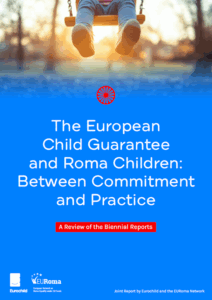EURoma Network and Eurochild have joined forces to review whether and how Roma children are being considered in the implementation of the European Child Guarantee in the 15 EU Member States involved in the EURoma Network and to make proposals for strengthening the role of the Child Guarantee in overcoming child poverty and social exclusion among Roma.
 EURoma Network and Eurochild release the report “The European Child Guarantee and Roma Children: Between Commitment and Practice – A Review of the Biennial Reports”. The report aims to assess whether and how Roma children are being considered in the implementation of the European Child Guarantee in the 15 Member States involved in the EURoma Network by looking at the biennial implementation reports that countries had to submit to the European Commission. Based on the findings of the analysis, it also puts forward a series of recommendations to strengthen the use of the Child Guarantee to overcome child poverty and social exclusion among Roma children by 2030.
EURoma Network and Eurochild release the report “The European Child Guarantee and Roma Children: Between Commitment and Practice – A Review of the Biennial Reports”. The report aims to assess whether and how Roma children are being considered in the implementation of the European Child Guarantee in the 15 Member States involved in the EURoma Network by looking at the biennial implementation reports that countries had to submit to the European Commission. Based on the findings of the analysis, it also puts forward a series of recommendations to strengthen the use of the Child Guarantee to overcome child poverty and social exclusion among Roma children by 2030.
The establishment of the European Child Guarantee framework marked a significant milestone in the EU’s commitment to combating child poverty and social exclusion, particularly among children in need, including Roma children. The consideration of “children with a minority ethnic origin, particularly Roma” as one of the six priority target groups in this EU policy instrument was a very important step forward, as it acknowledged the particular levels of inequality and disadvantage they face across the EU (according to the 2021 FRA report, 83 % of Roma children live in households at risk of poverty and one in two Roma children (54 %) lives in a household with severe material deprivation), and the need for a specific commitment and targeted interventions.
This policy instrument would also reinforce the EU Roma Strategic Framework for Equality, Inclusion and Participation for 2020-2030 in the achievement of their shared aim of reducing the inequalities experienced by Roma children across the EU
In addition, as established in the Recommendation for the Child Guarantee, EU Funds should play a crucial role in supporting its implementation, notably the European Social Fund Plus (ESF+) (with its 5% thematic allocation requirement for countries with rates of child poverty and social exclusion above the EU average of 23.4%) but also the European Regional Development Fund (ERDF) (by supporting long-term and integrated investments in a variety of fields), as well as other funding sources such as the REACT-EU, INVEST-EU and the Recovery and Resilience Facility.
However, despite the formal commitments, the existing resources and the explicit acknowledgment as one of the specific groups whose needs require particular attention, the analysis carried out raises concerns as to whether Roma children are benefiting from the measures and investments made under this policy framework and therefore to what extent is the Child Guarantee is fulfiling its goal of contributing to overcoming the situation of extreme poverty and exclusion of Roma children across the EU and ensuring that no child is left behind.
Against this background and convinced that there is still time to realise the potential of the Child Guarantee, a comparative analysis of the situation in different countries has been carried out. The aim is to identify existing challenges and propose concrete recommendations to bridge the gap between policy commitments and practical implementation and to re-emphasise that Roma children are a priority target group within the remit of the Child Guarantee.
We trust that the report serves as a valuable resource for relevant stakeholders, including policy-makers, funds authorities, practitioners and other stakeholders working to ensure that the European Child Guarantee truly reaches and benefits all children, including Roma children across the European Union.
Main findings
This analysis highlights that progress has been made but that there are still persistent challenges in implementing the Child Guarantee for Roma children as follows:
- Lack of strategic focus on Roma children: In many countries, the focus on Roma children is diluted by including them under broader categories of children in need or disadvantaged groups, reducing the specificity of targeted investments.
- Lack of clarity in resource allocation: It is not clear whether reported investments represent additional resources or existing programmes. The inability to distinguish between newly allocated resources and re-packaged, pre-existing programmes, and the insufficient disaggregation of Roma-specific spending within broader budget allocations remain a challenge.
- EU Funding concerns: There is a lack of clarity on whether and how EU funds (ESF+/ERDF) are being utilised to their full potential, and whether they are genuinely mobilising new resources together with national/regional funding.
- Governance and coordination challenges: Fragmented institutional structures create implementation barriers at multiple levels, characterised by the inadequate involvement of National Roma Contact Points in Child Guarantee processes, and there is poor vertical coordination between national policies and regional/local implementation authorities.
- Data gaps in the monitoring system: The absence of Roma-specific data and robust monitoring frameworks – hindered by methodological barriers including fears of discrimination and privacy concerns – undermines evidence-based decision-making, resource allocation, outcome tracking, and accountability mechanisms needed to translate commitments into measurable improvements for Roma children.
Recommendations
 Given the challenges identified, the following recommendations are put forward to strengthen the use of the Child Guarantee to overcome child poverty and social exclusion among Roma children by 2030:
Given the challenges identified, the following recommendations are put forward to strengthen the use of the Child Guarantee to overcome child poverty and social exclusion among Roma children by 2030:
1. Strengthen and expand targeted interventions for Roma children
- Increase the design of targeted interventions for Roma
- Focus on the most tangible manifestations of extreme poverty, where Roma children are over-represented, such as segregated areas, including settlements, and pockets of extreme poverty.
2. Enhance strategic mobilisation of EU Funding and clarity as regards the use of the Funds
- Establish clear budget lines within national financial reporting systems dedicated to Roma-focused initiatives, paired with standardised tracking mechanisms to measure investment impact on child outcomes.
- Increase strategic deployment of EU funding instruments, moving beyond the minimum 5% ESF+ allocation for child poverty to leverage the full potential of both ESF+ and ERDF in combination.
- Expand the role of the ERDF to address territorial disparities affecting Roma communities, particularly in segregated settlements where extreme deprivation persists.
The EURoma reference document on the Child Guarantee provides detailed information on the options for using the ESF+ and the ERDF for programmes to implement the Child Guarantee.
3. Improve governance mechanisms and policy coherence
- Increase the alignment of measures for Roma children in the National Action Plans (NAPs) with the National Roma Strategic Frameworks (NRSFs) to effectively address the multifaceted needs of Roma children and enhance impacts on poverty, inequality, and social exclusion.
- Enhance cooperation between National Roma Contact Points (NRCPs) and National Coordinators of the Child Guarantee at Member States level, to improve the design, implementation and monitoring of measures and investments, ensuring more effective dialogue and collaboration between these key stakeholders
- Strengthen governance mechanisms between national public authorities and regional or local administrations in Member States with a decentralised structure, where key competences for reducing child poverty are held at the sub-national level.
- Integrate Roma child poverty into the European Semester framework
- Ensure participatory governance in the Child Guarantee
4. Strengthen data collection systems and develop robust monitoring frameworks
- Promote the consistent collection and use of anonymised, disaggregated child welfare data by ethnicity
- Establish standardised methodologies for ethnic data collection across regions and Member States
- Develop comprehensive monitoring systems based on clear, outcome-focused indicators to assess the effectiveness of measures targeting Roma children.
- Integration by the European Commission of specific indicators on Roma children into the Joint Monitoring Framework of the European Child Guarantee. The European Union Agency for Fundamental Rights (FRA) could support this process by refining monitoring indicators, conducting targeted research (e.g. Roma Surveys), and providing guidance to both Member States and the European Commission
The future success of the Child Guarantee depends on its ability to systematically address these challenges through coordinated efforts at local, regional, national and EU levels, with a clear focus on the needs of particularly vulnerable groups, especially Roma children.
Further information
- Joint EURoma Network and Eurochild report “European Child Guarantee and Roma Children: Between Commitment and Practice – A Review of the Biennial Reports”
- European Commission’s dedicated website including Child Guarantee National action plans and implementation reports 2023-2025
- EURoma Network reference document “How to guarantee that the European Child Guarantee efficiently tackles Roma children’s poverty and inequality gap?” (2022)
- Eurochild publication “National Action Plans at a glance” (2022)


